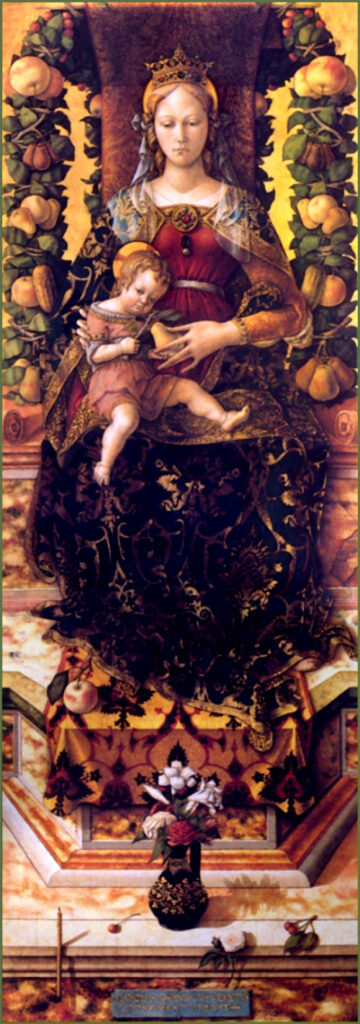Sometimes we hear people say, “Is no one writing beautiful music any more?” If you have wondered this as well, here is happy news. The day when “modern music” equated to purely mathematical constructions (twelve-tone system) and acerbic sounds is long over. Particularly in the arena of new compositions for choruses and wind ensembles, sheaves of beautiful modern music await our discovery.
These two settings of Jesus Christ, the Apple Tree provide examples of such beauty from the 20th and 21st centuries. The poem that sparked them both first appeared in an English publication called Spiritual Magazine in 1761 and likely was written by a pastor named Rev. Richard Hutchens.

The tree of life my soul hath seen,
Laden with fruit and always green;
The trees of nature fruitless be,
Compared with Christ the Apple Tree.
His beauty doth all things excel,
By faith I know but ne’er can tell
The glory which I now can see,
In Jesus Christ the Apple Tree.
For happiness I long have sought,
And pleasure dearly I have bought;
I missed of all but now I see
‘Tis found in Christ the Apple Tree.
I’m weary with my former toil –
Here I will sit and rest awhile,
Under the shadow I will be,
Of Jesus Christ the Apple Tree.
With great delight I’ll make my stay,
There’s none shall fright my soul away;
Among the sons of men I see
There’s none like Christ the Apple Tree.
I’ll sit and eat this fruit divine,
It cheers my heart like spirit’al wine;
And now this fruit is sweet to me,
That grows on Christ the Apple Tree.
This fruit doth make my soul to thrive,
It keeps my dying faith alive;
Which makes my soul in haste to be
With Jesus Christ the Apple Tree.
A number of composers subsequently set it to music The best known of these settings is by British composer Elizabeth Poston (1905-1987). She concerned herself throughout her career with the integrity of our folk-music heritage as well as its possibilities when woven into Western musical forms. Her musical vision for the poem, published in 1967, starts with a lovely, single-line melody in folk style—a melody she has published six years earlier in a book of children’s songs. The subsequent verses grow richer in choral harmony, but also draw back at times, giving the lines a pulsating feeling of gently louder, then softer, drama.
In the final part of this performance by Seraphic Fire, the singers form a circle around their listeners. Each singer returns to the opening melody, singing it in an untimed or improvised round. That this improvisation works so well says much about the purity and power of a well-crafted tune. The resulting surround-sound also reminds us why the experience of hearing music in person cannot be replaced.
After enjoying the poem and Poston’s setting, here is another, very recent composition by Stanford Scriven (b. 1988). Should you be familiar with the deeply moving works of the beloved Stephen Paulus (1949-2014)—a fabulous example of a composer who dipped into the well of Beauty—you may sense a kinship between his and Scriven’s styles.
Both the poem and these two compositions allow us to deflect our automatic association of “the apple” with the starkness of the forbidden fruit in the Garden of Eden. It can be a surprise to discover that the Bible offers other, quite beautiful passages about apples, including this one from Zechariah (2:8):
For thus saith the Holy One; After the glory hath he sent me unto the nations which spoiled you: for he that toucheth you toucheth the apple of his eye.
Or this sumptuous verse in (not surprisingly) Song of Solomon (2:3):
As the apple tree among the trees of the wood, so is my beloved among the sons.
For that matter, scholars remind us that the fruit generally translated “apple” in biblical accounts would not have been an apple as we know it (due to the realities of heat and rainfall in the Holy Land). Instead, they suggest the apricot, quince, or a fruit from a shrub called the potato-apple as better candidates for the rendition of “apple.”
Yet in Hutchens’ poem, we find the apple exactly as we know it. An Englishman, Hutchens knew the patience needed to bring a sapling fruit tree to fruition and what it means to anticipate its ripening fruit and the sweet flavor it will offer at harvest time. Furthermore, where would Western art be if we removed the standard trunk and branches of a tree bedecked with red apples from Western religious art as varied as icons, paintings, mosaics, and stained-glass windows?
So often at Christmastime we think of sweets in terms of cookies and peppermint sticks. Perhaps this year offers us a chance to renew apples as a mainstay of the Christmas feast. We can remind the children what a wonderful gift an apple is, both as a spiritual symbol (“This fruit doth make my soul to thrive”) and as one of few life-sustaining foods that can absorb outward physical stress and endure to take us through the long winter storms.




I love that song.
Excellent!